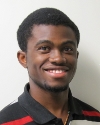2010 REU and REV Program Participant Profiles: Ejebagom John Ojogbo
 |
Major: Computer Science |
What is the purpose of your research, and what does the research ultimately accomplish?
The project aims to create a mathematical model that describes the current state of the pet population in Knox County and that can provide measures to reduce overpopulation. Ultimately, we hope to present a viable method of spaying and neutering pets that will reduce shelter intake and in turn euthanasia of these pets in the shelters.
Describe a typical day on the job:
The day starts with all group members meeting to discuss what has been done so far. We then develop the model; some members do research and look for literature, other do coding and mathematics. Depending on the program schedule, we may have lectures or talks at the NIMBioS building or meetings with our supervising professors.
What new experiences did you gain that have helped you today?
I gained a better understanding of the pet situation in the United States. I learned how to code in some mathematical languages, and I got a lot of background knowledge in biology.
Would you recommend our program to others?
Yes I would. I believe it brings an essential mixture of disciplines that is required in solving a lot of the problems in the world today. I also found the panels organized by the program, such as the graduate student panel and the career opportunities panel, were very helpful in deciding what I wanted to do with my life.
NIMBioS
1122 Volunteer Blvd., Suite 106
University of Tennessee
Knoxville,
TN 37996-3410
PH: (865) 974-9334
FAX: (865) 974-9461
Contact NIMBioS


